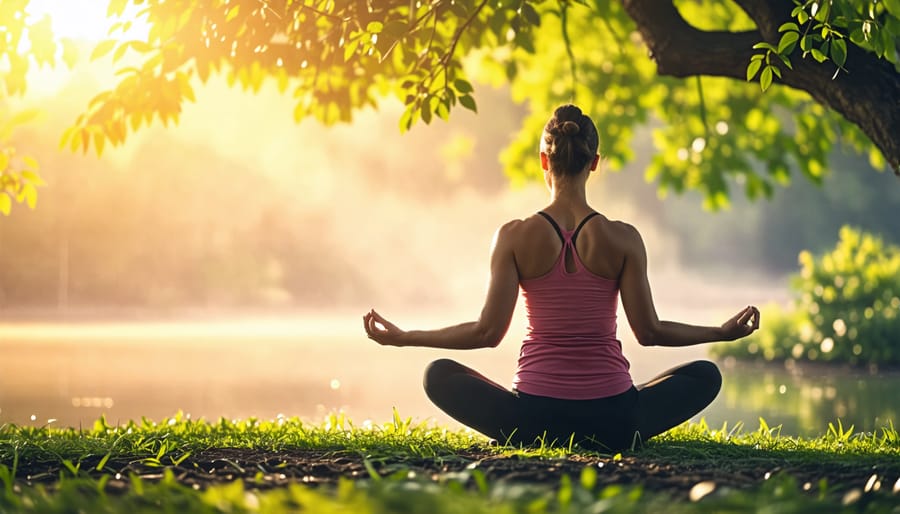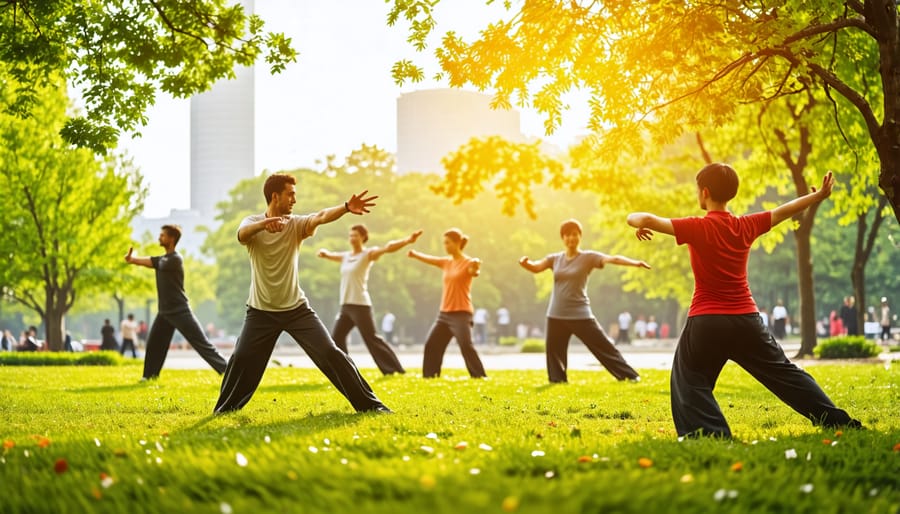Discover the power of mindful movement for enhanced physical and mental health. Engage in practices like yoga, tai chi, or qigong that combine gentle movements with deep breathing and focused awareness to reduce stress, improve flexibility, and boost mood. Take regular movement breaks throughout the day, even if just for a few minutes, to reconnect with your body and reset your mind. Approach each mindful movement session with a non-judgmental attitude, letting go of expectations and tuning into the present moment. With consistent practice, mindful movement can become a powerful tool for cultivating resilience, balance, and overall health in your daily life.

Yoga
Beginner-Friendly Yoga Poses
Here are some beginner-friendly yoga poses that can help you get started with a mindful movement practice:
1. Mountain Pose (Tadasana): Stand with your feet hip-width apart, engage your core, and imagine a straight line from your head to your heels. This grounding pose helps improve posture and body awareness.
2. Child’s Pose (Balasana): Kneel on the floor, sit back on your heels, and stretch your arms forward. This gentle pose relieves tension in the back, hips, and shoulders while promoting relaxation.
3. Cat-Cow Stretch (Marjaryasana-Bitilasana): Start on your hands and knees. As you inhale, arch your back and look up (Cow). On the exhale, round your spine and tuck your chin to your chest (Cat). This flow helps mobilize the spine and ease back pain.
4. Downward-Facing Dog (Adho Mukha Svanasana): From hands and knees, lift your hips and straighten your arms and legs, forming an inverted V-shape. This foundational pose stretches the hamstrings, calves, and shoulders while strengthening the arms and legs.
5. Warrior I (Virabhadrasana I): From a lunge position, lift your torso and raise your arms overhead. Keep your front knee bent and back leg straight. This energizing pose builds strength and stability in the legs and core.
Remember to move slowly, breathe deeply, and listen to your body. If any pose feels uncomfortable or causes pain, modify it or skip it altogether. With regular practice, you’ll develop greater flexibility, balance, and body awareness – key components of a mindful movement practice.
Mindfulness in Yoga Practice
Incorporating mindfulness into your yoga practice can enhance both the physical and mental benefits of this ancient discipline. Begin by setting an intention for your practice, focusing on being present in the moment. As you move through each asana (pose), bring your attention to your breath, noticing how it flows in and out of your body. Engage your senses fully, observing any physical sensations, thoughts, or emotions that arise without judgment. When your mind wanders, gently guide it back to your breath and the present moment. During challenging poses, practice self-compassion and acceptance, honoring your body’s limits. As you transition between asanas, maintain a mindful awareness of your movements, cultivating grace and fluidity. Throughout your practice, remember to listen to your body, adapting poses as needed and respecting any limitations. By infusing mindfulness into your yoga routine, you can cultivate a deeper sense of mind-body connection and reap the full rewards of this transformative practice.
Tai Chi

Basic Tai Chi Movements
Tai Chi, an ancient Chinese practice, combines gentle, flowing movements with deep breathing and meditation. Some of the basic Tai Chi movements include “Commencement,” which involves standing with feet shoulder-width apart and arms relaxed at the sides, and “Part the Wild Horse’s Mane,” where practitioners step to the side and sweep their arms in a circular motion. Another fundamental movement is “Wave Hands Like Clouds,” which involves shifting weight from one foot to the other while moving the arms in a continuous, wavelike pattern.
These movements are designed to promote balance, flexibility, and coordination while calming the mind and reducing stress. By focusing on the precise execution of each movement and synchronizing them with deep, controlled breathing, practitioners cultivate a heightened sense of body awareness and mindfulness. Regular practice of these basic Tai Chi movements can lead to improved posture, increased circulation, and enhanced overall well-being. As individuals progress in their practice, they can learn more advanced movements and sequences, further deepening the mind-body connection and reaping the numerous health benefits associated with this gentle, yet powerful, form of mindful movement.
Tai Chi for Stress Reduction
Tai Chi, an ancient Chinese practice combining slow, graceful movements with deep breathing and meditation, offers an effective way to manage stress and promote relaxation. The gentle, flowing movements help to release tension in the body, while the focus on breath and mindfulness calms the mind. Research has shown that regular Tai Chi practice can reduce stress hormones, improve mood, and enhance overall well-being. By incorporating Tai Chi into your daily routine, you can cultivate a sense of inner peace and resilience, better equipping you to handle life’s challenges with greater ease and balance.

Qigong
Qigong Breathing Techniques
Qigong breathing techniques, or “Tu Na,” focus on deep, diaphragmatic breathing to promote relaxation and balance energy flow. One basic technique is “Abdominal Breathing,” where you place your hands on your lower abdomen and breathe slowly and deeply through your nose, feeling your abdomen expand and contract. Another technique, “Reverse Abdominal Breathing,” involves contracting your abdomen during inhalation and expanding it during exhalation. These techniques can help reduce stress, improve lung capacity, and increase oxygen supply to the body. Additionally, coordinating breath with gentle movements in Qigong practice can further enhance mind-body awareness and promote overall well-being. Incorporating Qigong breathing techniques into your daily routine can lead to a greater sense of calm, focus, and vitality.
Simple Qigong Exercises
Here are a few simple Qigong exercises to get you started:
1. Standing meditation: Stand with feet shoulder-width apart, knees slightly bent, and arms relaxed at your sides. Focus on your breath and clear your mind. Hold for 2-5 minutes.
2. Lifting the sky: Stand with feet shoulder-width apart. Slowly lift your arms overhead as you inhale, then lower them back down as you exhale. Repeat 8-10 times.
3. Holding the ball: Imagine holding a ball of energy between your hands. Move your hands in a circular motion, as if gently rotating the ball. Do this for 1-2 minutes.
Remember to breathe deeply and move slowly with intention. With regular practice, these exercises can help improve balance, reduce stress, and promote overall well-being.
Walking Meditation
Walking meditation is a simple yet powerful way to bring mindfulness into your daily routine. Unlike seated meditation, walking meditation allows you to focus on the physical sensations of movement while cultivating mental clarity and relaxation. To begin, find a quiet space where you can walk comfortably, such as a park, beach, or even your backyard. Start by standing still and taking a few deep breaths, bringing your attention to the present moment. As you begin walking, maintain a slow, steady pace, keeping your gaze softly focused a few feet ahead of you. Notice the sensations of your feet making contact with the ground, the movement of your legs, and the rhythm of your breath. If your mind wanders, gently redirect your attention back to the physical sensations of walking. You can also silently repeat a calming phrase or mantra with each step, such as “peace” or “I am present.” Continue this practice for 10-20 minutes, or for a set distance, allowing yourself to fully immerse in the experience of mindful walking. Over time, you may find that walking meditation helps reduce stress, improves concentration, and promotes a greater sense of well-being. By incorporating this simple practice into your routine, you can transform your daily walks into opportunities for mindfulness, self-care, and rejuvenation.
Conclusion
In conclusion, mindful movement practices like yoga, tai chi, and qigong offer a holistic approach to wellness that can benefit both the body and mind. By incorporating mindful breathing, focused attention, and gentle physical movements, these practices can help reduce stress, improve flexibility and balance, and enhance overall well-being. Whether you’re looking to manage chronic pain, boost your mood, or simply find a more peaceful way to move your body, mindful movement can be a valuable addition to your wellness routines. Remember, the key is to start slowly, listen to your body, and choose a practice that resonates with you. With regular practice and patience, you may discover that mindful movement not only improves your physical health but also brings a greater sense of calm, balance, and joy to your life.

